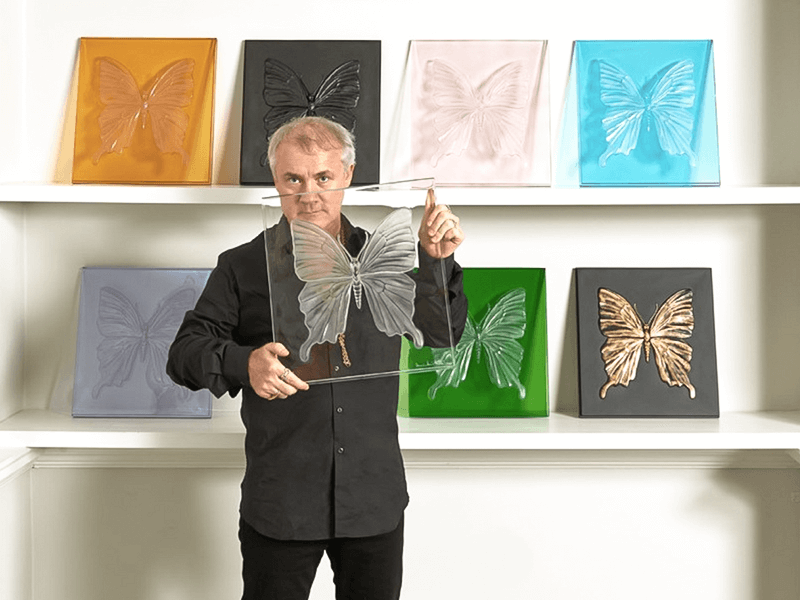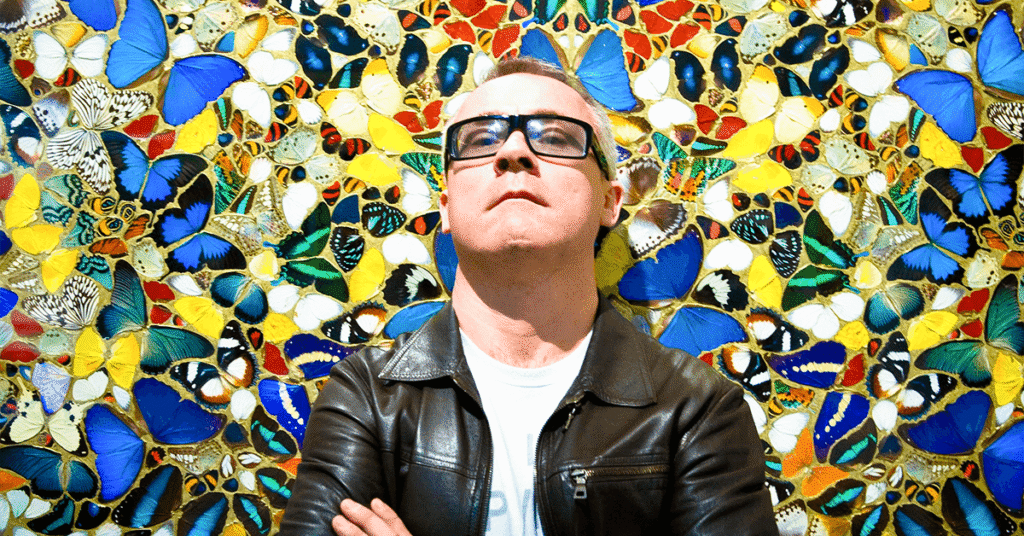The Damien Hirst biography is one marked by bold creativity, controversy, and a relentless push against the boundaries of traditional art. As one of the most influential and controversial contemporary artists, Hirst’s work has continually challenged societal norms and redefined the art world. Known for his iconic pieces such as The Physical Impossibility of Death in the Mind of Someone Living, Hirst has reshaped conceptual art, fusing elements of mortality with art’s commercial side.
Quick Highlights:
- Birthdate: June 7, 1965
- Breakout Role: Member of the Young British Artists (YBAs) in the 1990s
- Major Recognition: Turner Prize winner (1995)
- Notable Achievements: Iconic works such as The Physical Impossibility of Death in the Mind of Someone Living and For the Love of God
- Personal Life: Advocate for art as a form of personal expression and a challenge to established norms
Early Life & Education
Born in Bristol, England, Damien Hirst’s journey into the art world wasn’t straightforward. After attending Goldsmiths College in London, he quickly rose to prominence as a member of the Young British Artists (YBAs), a group known for their provocative and daring approach to contemporary art. The Damien Hirst biography begins to take shape during this period when his works began gaining the attention of critics and collectors alike, setting the foundation for his future success.
Breakthrough Works: The Physical Impossibility of Death in the Mind of Someone Living
In 1991, Damien Hirst’s biography took a significant turn with the creation of his landmark work The Physical Impossibility of Death in the Mind of Someone Living. The piece, featuring a shark suspended in formaldehyde, immediately captured global attention. This shocking and thought-provoking piece marked Hirst’s rise as a leading contemporary artist, forever associating his name with themes of mortality and existence. It solidified his place in the art world and changed how art was perceived, both in its subject matter and presentation.
Turner Prize and Global Recognition
By 1995, Damien Hirst’s career had reached a new height when he was awarded the Turner Prize. This honor was a major milestone in his Damien Hirst biography, marking his place as one of the most important contemporary artists of his generation. The years following this recognition saw Hirst’s works displayed in major exhibitions worldwide. His distinctive approach to art—often utilizing dead animals preserved in formaldehyde—continued to spark conversations and debates, establishing him as both a visionary and a controversial figure.
For the Love of God and the Commercialization of Art
In 2007, Hirst unveiled one of his most famous works, For the Love of God, a platinum skull encrusted with diamonds. Valued at over £50 million, it showcased Hirst’s ability to blend high art with commercial appeal. This work, along with his groundbreaking 2008 Sotheby’s auction—where he bypassed traditional galleries to sell his works directly to buyers—signified the growing intersection of art and commerce in Hirst’s career. The piece’s commercial success further boosted Hirst’s net worth and placed him at the forefront of the art world’s financial revolution.
Controversy and Criticism
Throughout his career, Damien Hirst has faced significant criticism, especially for his use of dead animals and disturbing imagery. Critics have often questioned whether his work lacks depth or is merely sensationalist. However, the Damien Hirst biography shows that his bold approach to art was never about creating comfort—it was about forcing people to confront uncomfortable truths about life, death, and commercialization. Despite the controversy, Hirst’s art has continued to provoke thought and spark important discussions, adding to his mystique and securing his place in art history.

Damien Hirst’s Legacy and Global Influence
Today, Damien Hirst’s influence on the art world is undeniable. His works are featured in major museums and private collections, and his pieces continue to sell for record-breaking prices at auctions. The Damien Hirst biography is a testament to his ability to challenge norms, evolve with the times, and redefine the boundaries of what is considered art. His ability to merge art with business, while maintaining an artistic vision, ensures that his legacy will endure for years to come.
What’s Next for Damien Hirst?
Looking to the future, Damien Hirst shows no signs of slowing down. His ability to provoke, challenge, and innovate ensures that his influence on contemporary art will continue. With new exhibitions, art auctions, and collaborations on the horizon, Hirst’s career will likely keep evolving, further shaping the art world and adding to his ever-growing legacy.
Damien Hirst: A Biography of Reinvention
From his early works exploring life and death to his position as one of the most commercially successful artists of the 21st century, Damien Hirst has continually reinvented himself. His work has left a lasting mark on the art world, proving that art is not just about what is seen but about the conversations it starts. As Hirst continues to create, his place in the art world remains secure, making his biography one of the most fascinating in contemporary art history.
FAQs About Damien Hirst
- How did Damien Hirst start his career?
Hirst began his career at Goldsmiths College in London, where he became a key figure in the Young British Artists (YBAs). His early works gained immediate attention for their controversial use of preserved animals, setting the stage for his success. - What is Damien Hirst most famous for?
Hirst is most famous for his provocative works involving dead animals preserved in formaldehyde, such as The Physical Impossibility of Death in the Mind of Someone Living and his diamond-encrusted skull For the Love of God. - What causes does Damien Hirst support?
Hirst has supported various charitable causes, particularly those related to healthcare and the arts. His works often explore themes of mortality, ethics, and the human condition, making him an advocate for discussions surrounding these issues. - What upcoming projects does Damien Hirst have?
Hirst continues to work on large-scale art installations and exhibitions. His future projects are expected to further explore themes of life, death, and the commercialization of art. - How has Damien Hirst impacted his industry?
Hirst has had a significant impact on contemporary art by challenging conventions and the commercialization of art. His record-breaking auction sales and innovative approaches to art have shaped the modern art world.
Call to Action
What do you think about Damien Hirst biography and his revolutionary impact on the art world? Share your thoughts in the comments below! If you enjoyed this post, don’t forget to share it with your friends and stay tuned for more insights into the lives of iconic artists!

